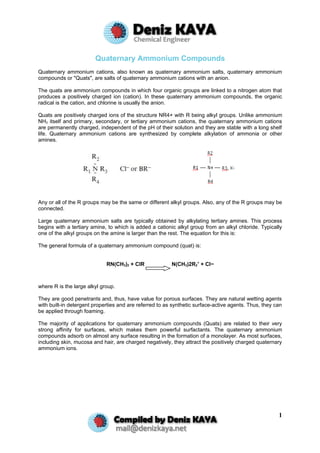
Quaternary Ammonium Compounds
- 1. Quaternary Ammonium Compounds Quaternary ammonium cations, also known as quaternary ammonium salts, quaternary ammonium compounds or "Quats", are salts of quaternary ammonium cations with an anion. The quats are ammonium compounds in which four organic groups are linked to a nitrogen atom that produces a positively charged ion (cation). In these quaternary ammonium compounds, the organic radical is the cation, and chlorine is usually the anion. Quats are positively charged ions of the structure NR4+ with R being alkyl groups. Unlike ammonium NH3 itself and primary, secondary, or tertiary ammonium cations, the quaternary ammonium cations are permanently charged, independent of the pH of their solution and they are stable with a long shelf life. Quaternary ammonium cations are synthesized by complete alkylation of ammonia or other amines. Any or all of the R groups may be the same or different alkyl groups. Also, any of the R groups may be connected. Large quaternary ammonium salts are typically obtained by alkylating tertiary amines. This process begins with a tertiary amine, to which is added a cationic alkyl group from an alkyl chloride. Typically one of the alkyl groups on the amine is larger than the rest. The equation for this is: The general formula of a quaternary ammonium compound (quat) is: RN(CH3)2 + ClR N(CH3)2R2+ + Cl− where R is the large alkyl group. They are good penetrants and, thus, have value for porous surfaces. They are natural wetting agents with built-in detergent properties and are referred to as synthetic surface-active agents. Thus, they can be applied through foaming. The majority of applications for quaternary ammonium compounds (Quats) are related to their very strong affinity for surfaces, which makes them powerful surfactants. The quaternary ammonium compounds adsorb on almost any surface resulting in the formation of a monolayer. As most surfaces, including skin, mucosa and hair, are charged negatively, they attract the positively charged quaternary ammonium ions. 1
- 2. General structure and examples of quaternary ammonium compounds (QACs) The quaternary ammonium compounds contain a hydrophobic has an oily character and thus it repels water. When absorbed on surfaces this oily group extends outwards from the surface as illustrated below: 2
- 3. The formation of this monolayer of oil and the neutralization of surfaces, as well as their good wetting and adhesive properties, form the basis for the utilization of quaternary ammonium compounds (Quats) in many different fields of application. Certain long alkyl chain quaternary ammonium compounds are used as antimicrobials and disinfectants. For a QAC to have a high antimicrobial activity, at least one of the R groups must have a chain length in the range C8 to C18 The bactericidal action of quaternary compounds has been attributed to inactivation of energy- producing enzymes, denaturation of proteins, and disruption of the cell membrane. These agents are bacteriostatic, fungistatic, and sporistatic and also inhibit algae. They are bactericidal for gram-positive bacteria and moderately active against gram-negative bacteria (such as E. coli, P. aeruginosa and S. Typhimurium). Lipophilic viruses (such as herpes simplex, vaccinia, influenza and adenoviruses) are inactivated. They are not tuberculocidal or sporicidal, and they do not inactivate hydrophilic viruses. The quats act against microorganisms differently than do chlorine and iodine compounds. They form a residual antimicrobial film after being applied to surfaces. Although the film is bacteriostatic, these compounds are selective in the destruction of various microorganisms. The quats do not kill bacterial spores but can inhibit their growth. Quaternary ammonium compounds are more stable in the presence of organic matter than are chlorine and iodine sanitizers, although their bactericidal effectiveness is impaired by the presence of organic matter. Stainless steel and polycarbonate are more readily sanitized by the quats than are either the abraded polycarbonate or mineral resin surfaces. Quats are nonconcorrosive and nonirritating to the skin, and have no taste or odor in use dilutions. The concentration of quat solutions is easy to measure. The quats are low in toxicity and can be neutralized or made ineffective by using any anionic detergent. Quat sanitizers are generally more effective in the alkaline pH range. However the effect of pH may vary with bacterial species, with gram-negative bacteria being more susceptible to quats in the acid pH range and gram-positive microbes in the alkaline range. They are inactivated by anionic detergents (soaps), by many nonionic detergents, and by calcium, magnesium, ferric, and aluminum ions. Also, they are not recommended to be used in hard water. Effective levels are at 200 ppm. The quaternary ammonium compounds should not be combined with cleaning compounds for subsequent cleaning and sanitizing because they are inactivated through detergent ingredients such as anionic wetting agents. However, an increase in alkalinity through formulation with compatible detergents may enhance the bactericidal activity of the quats. 3
- 4. The quats have the following major advantages: • Colorless and odorless • Stable against reaction with organic matter • Resistant to corrosion of metals and not affected by hard water • Stable against temperature fluctuation with a long shelf life • Nonirritating to the skin • Effective at a high pH with detergency and soil penetration ability • Effective against mold growth • Nontoxic • Good surfactants that provide a residual antimicrobial film 4